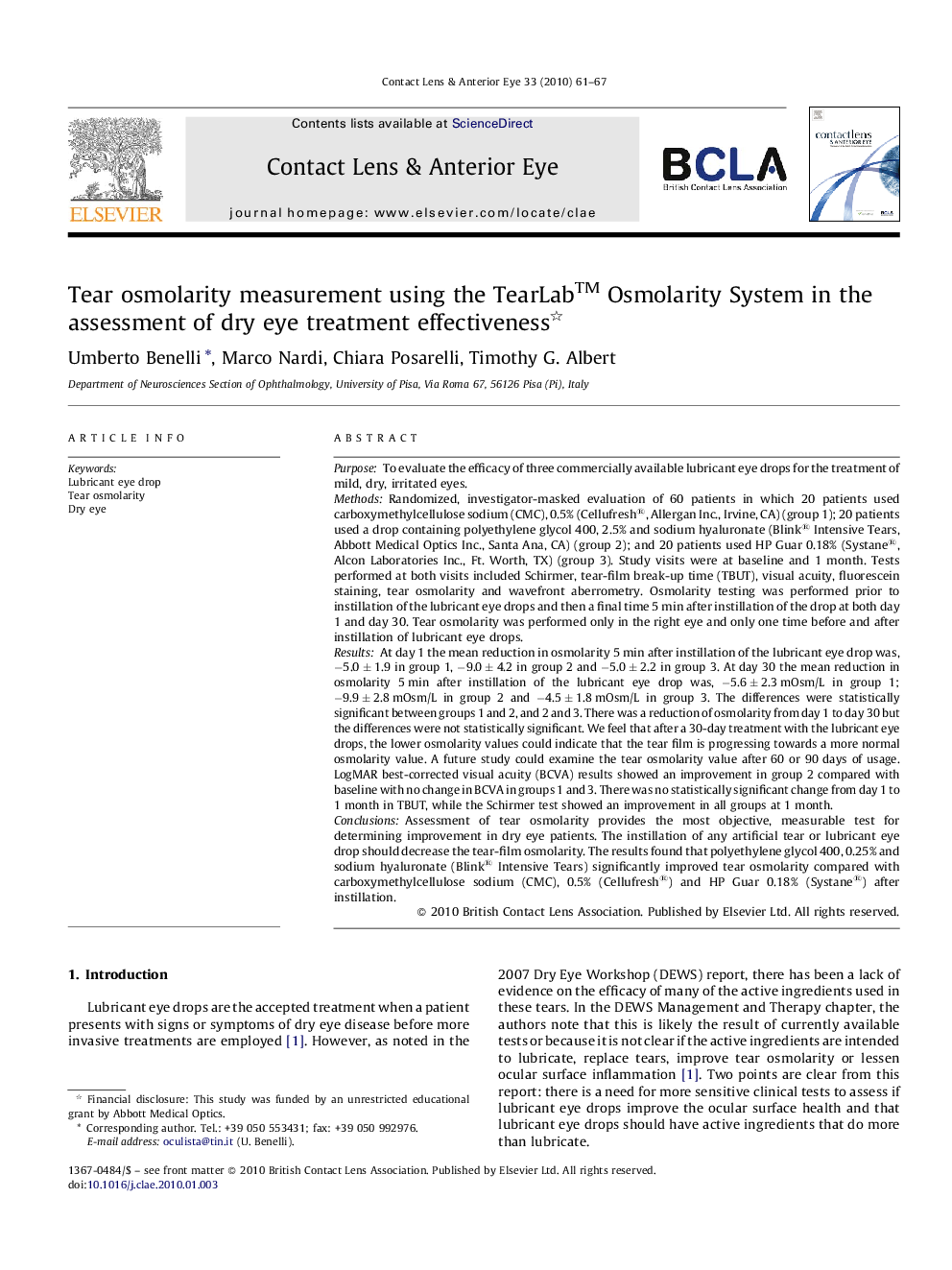| کد مقاله | کد نشریه | سال انتشار | مقاله انگلیسی | نسخه تمام متن |
|---|---|---|---|---|
| 2696951 | 1143873 | 2010 | 7 صفحه PDF | دانلود رایگان |

PurposeTo evaluate the efficacy of three commercially available lubricant eye drops for the treatment of mild, dry, irritated eyes.MethodsRandomized, investigator-masked evaluation of 60 patients in which 20 patients used carboxymethylcellulose sodium (CMC), 0.5% (Cellufresh®, Allergan Inc., Irvine, CA) (group 1); 20 patients used a drop containing polyethylene glycol 400, 2.5% and sodium hyaluronate (Blink® Intensive Tears, Abbott Medical Optics Inc., Santa Ana, CA) (group 2); and 20 patients used HP Guar 0.18% (Systane®, Alcon Laboratories Inc., Ft. Worth, TX) (group 3). Study visits were at baseline and 1 month. Tests performed at both visits included Schirmer, tear-film break-up time (TBUT), visual acuity, fluorescein staining, tear osmolarity and wavefront aberrometry. Osmolarity testing was performed prior to instillation of the lubricant eye drops and then a final time 5 min after instillation of the drop at both day 1 and day 30. Tear osmolarity was performed only in the right eye and only one time before and after instillation of lubricant eye drops.ResultsAt day 1 the mean reduction in osmolarity 5 min after instillation of the lubricant eye drop was, −5.0 ± 1.9 in group 1, −9.0 ± 4.2 in group 2 and −5.0 ± 2.2 in group 3. At day 30 the mean reduction in osmolarity 5 min after instillation of the lubricant eye drop was, −5.6 ± 2.3 mOsm/L in group 1; −9.9 ± 2.8 mOsm/L in group 2 and −4.5 ± 1.8 mOsm/L in group 3. The differences were statistically significant between groups 1 and 2, and 2 and 3. There was a reduction of osmolarity from day 1 to day 30 but the differences were not statistically significant. We feel that after a 30-day treatment with the lubricant eye drops, the lower osmolarity values could indicate that the tear film is progressing towards a more normal osmolarity value. A future study could examine the tear osmolarity value after 60 or 90 days of usage. LogMAR best-corrected visual acuity (BCVA) results showed an improvement in group 2 compared with baseline with no change in BCVA in groups 1 and 3. There was no statistically significant change from day 1 to 1 month in TBUT, while the Schirmer test showed an improvement in all groups at 1 month.ConclusionsAssessment of tear osmolarity provides the most objective, measurable test for determining improvement in dry eye patients. The instillation of any artificial tear or lubricant eye drop should decrease the tear-film osmolarity. The results found that polyethylene glycol 400, 0.25% and sodium hyaluronate (Blink® Intensive Tears) significantly improved tear osmolarity compared with carboxymethylcellulose sodium (CMC), 0.5% (Cellufresh®) and HP Guar 0.18% (Systane®) after instillation.
Journal: Contact Lens and Anterior Eye - Volume 33, Issue 2, April 2010, Pages 61–67